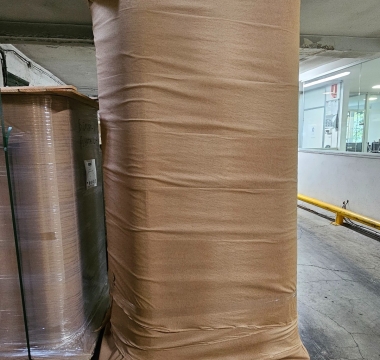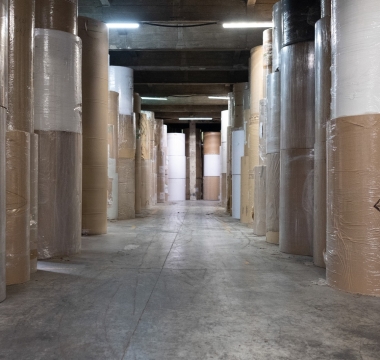- What is crepe paper?
Crepe paper is a type of paper subjected to a special crimping process, which gives it its distinctive crinkled texture. This design not only enhances its tear resistance but also provides exceptional flexibility, allowing it to wrap around and adjust to various shapes and volumes.
In addition to its elasticity, crepe paper is environmentally friendly, as it is often made from recycled or recyclable fibers. This makes it a sustainable solution for industries seeking to balance functionality with ecological responsibility.
- Key properties of crepe paper for sensitive products
Storing sensitive products requires materials that ensure protection without compromising product quality. Crepe paper stands out for its:
- Cushioning: Its crinkled structure absorbs impacts and vibrations, protecting fragile items during handling or transport.
- Adaptability: It can wrap products of various shapes and sizes, offering complete coverage without the need for multiple layers.
- Strength: Despite its lightness, crepe paper is robust and tear-resistant, making it ideal for intensive use.
- Scratch protection: Its soft texture prevents surface damage, such as scratches, on delicate items.
- Applications of crepe paper in sensitive product storage
Crepe paper is widely used in various industrial sectors to protect sensitive products. Common applications include:
- a) Glass and Ceramic Industry:
In packaging fragile items like glasses, plates, mirrors, or ceramic decorations, crepe paper acts as a cushioning barrier that prevents breakage and scratches. Its ability to adapt to curved or angular surfaces ensures optimal protection. - b) Electronics and delicate components:
Electronic equipment and components like circuit boards, sensors, or mobile devices require secure storage. Crepe paper shields these items from vibrations, moisture, and dust accumulation. - c) Food sector:
Although less commonly used for direct food storage, crepe paper serves as an external protective layer for shipping sensitive food products, such as wine bottles, oils, or glass jars. - d) Medical and surgical instruments:
In the medical field, maintaining the cleanliness and integrity of surgical instruments is essential. Crepe paper is used to wrap and protect these instruments during transport or storage, preventing physical damage and contamination.
- Advantages of crepe paper over other packaging materials
When compared to materials like bubble wrap, kraft paper, or sulfite paper, crepe paper offers specific advantages that make it a preferred solution:
- Eco-friendly: Unlike plastic, crepe paper is biodegradable and recyclable, contributing to reduced environmental impact.
- Lower volume: Its elasticity allows for thin wrapping that does not significantly increase packaging volume or weight.
- Cost-effective: While quality varies, crepe paper is often a more economical option than other specialized materials.
- How to choose the right crepe paper for your business
Not all crepe papers are the same, and selecting the type that best suits your business needs is important. Key factors to consider include:
- Weight: Higher-weight crepe paper offers greater resistance, ideal for heavier or more fragile items.
- Elasticity: Evaluate whether you need a more flexible or rigid material, depending on the type of product you store.
- Additional treatments: Some crepe papers come with specific treatments, such as moisture resistance or anti-static properties, ideal for electronics or pharmaceuticals.
- Success stories: Crepe paper in the industry
Companies in sectors like glass, ceramics, and electronics have reported significant improvements in product protection thanks to crepe paper. For example, a mirror manufacturer reduced transport-related damages by 25% by replacing bubble wrap with crepe paper in their packaging.
Similarly, in the medical sector, the use of crepe paper has enhanced the sterility of surgical instruments during storage and shipping, meeting the highest quality standards.
- Sustainability and environmental responsibility
In a context where companies aim to reduce their environmental footprint, crepe paper combines functionality with sustainability. Its manufacturing process uses less energy and generates less waste than plastic materials, and its biodegradability makes it a circular economy-friendly alternative.
Additionally, using recycled crepe paper helps conserve natural resources and reduce waste, reinforcing companies´ commitment to the environment.
- The future of crepe paper in the industry
As more sectors seek efficient and sustainable packaging solutions, crepe paper continues to establish itself as a key material. Innovations in its manufacturing and treatment are expanding its applications, from product protection to its use in decoration and industrial design.
In the future, we are likely to see crepe papers with specialized treatments, such as waterproof coatings or antimicrobial properties, opening new possibilities in sectors like medicine and food.
Conclusion
Crepe paper is essential for storing sensitive products thanks to its flexibility, strength, and sustainability. Its ability to adapt to diverse needs makes it an ideal solution for industries seeking efficient and environmentally friendly product protection.
At Arrosi, we specialize in producing high-quality crepe paper designed to meet the most demanding industry requirements. If your company is looking for packaging solutions that combine functionality and sustainability, crepe paper is undoubtedly the perfect choice.




